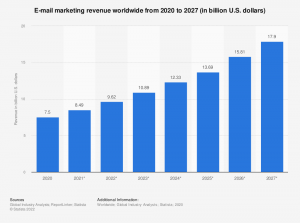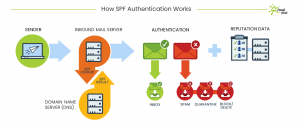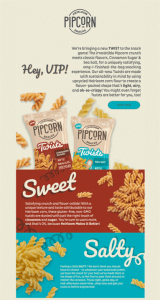
Dan Zarella, award-winning social media scientist, once said: “Email may well be your most productive marketing tool.” He is not wrong. Every day, we send and receive 347.3 billion emails on average. If you are not cashing in on email marketing leads, you are missing out on such a huge opportunity that might actually have the potential to explode your brand into prominence.
Yes, yes, you’d say in the age of TikTok, who even opens the email, let alone convert through it. Well, you are not just wrong, you are so wrong. According to Snovio Labs, in the year 2022, 89% of marketers said they use email as the primary channel for generating leads. And guess what, the average open rate was 19.66%. For some marketers, the rate was over 20%.
What? Are you not convinced yet? OK, here is a monetary stat for you. According to Litmus, email marketing has an impressive ROI of $36 for every $1 spent. Now, will you please stop frowning when we tell you to use email marketing to generate leads?

The process of generating email marketing leads
The trick to a successful email marketing campaign is to get a great insight into your audience and know exactly the message you want to convey. Why is it important? Let’s understand one thing, email marketing is as important as other forms of digital or social media marketing.
But here, you are sliding into people’s inboxes. Consumers don’t want to see messages in their email inbox with any random mumbo jumbo. They want a personalized experience that could convince them to convert from a potential to a recurring customer.
To nail the messaging, brands have to craft a compelling email marketing campaign where everything from the message to the template is personalized for each consumer.
Target audience
Identifying the target audience for the email list is the first step in creating an effective marketing campaign for email lead generation. The more precisely you can define your target audience, the more personalized and relevant your emails can be.

But before you delve into the process, start by clarifying your business objectives and goals for the email marketing campaign. What do you hope to achieve with it? Do you want to increase sales, or do you just want people to sign up for your newsletter? The objective could also be to build brand awareness or trigger lead generation through email marketing. Once you have a goal in sight, proceed to the next step of making a list of prospects who would be interested in what you are offering.
Curating an email list
The process of curating an email marketing list starts with gathering email addresses from various sources, including your website sign-up forms, previous customers, social media platforms, and other relevant sources.
Even though it might seem a simple task, you can very easily go wrong here. Why? Laws. See, various countries and regions have strong data collection and protection laws, like the General Data Protection Regulation (GDPR) in Europe or the CAN-SPAM Act in the US. Some of these laws require explicit consent from individuals before sending them marketing emails. So, whichever region or country you are operating in, make sure your data collection complies with the laws there so that you don’t land into any legal trouble.
Once you are ironclad with your legal compliance, the next step is segmentation – dividing your email list based on criteria such as demographics, geographic location, purchase history, and engagement level. This helps in sending targeted and relevant content to specific subscribers.
After you have a list of addresses, use email verification tools to validate the authenticity and deliverability of email addresses on your list. These tools can check for syntax errors and whether the domain is active or not. Some of these tools are:
- ZeroBounce
- Hunter Email Verifier
- NeverBounce
- Clearout
- BriteVerify
- EmailListVerify
- DataValidation
- Mailgun
- Verifier
Email marketing platform
Now that you have created buyers’ personas and you have a list of email addresses, the next stage is to choose software for your email marketing campaign. Of course, you are not going to send every email personally. You need to automate the process, and this is done by email marketing software.
Choosing the right software for your campaign involves several technical and strategic considerations, like:
Define your requirements: This includes the size of your email list, what kind of automation you need, your templates and design requirements, what level of integration you are looking for, and what analytics you need to track the campaign’s performance.
Credibility: You need your emails to land in the inbox and not in spam folders. For that, you need credible software. Make sure you choose software that complies with authentication methods like Sender Policy Framework (SPF), Domain Keys Identified Mail (DKIM), Domain-based Message Authentication, Reporting and Conformance (DMARC) and Brand Indicators for Message Identification (BIMI) specification. These authentications help in verifying whether the message has come from a trustworthy source or is spam.

Segmentation: Select a tool that enables you to segment your email list based on different criteria like demographics, behavior, or engagement and allows personalization features, like dynamic content insertion.
Design and templates: Consider your design requirements and see if the software offers tools to easily create visually appealing emails with customizable templates to get your message across to the users and make them click the CTA.
Analytics: This is a vital consideration when choosing email marketing software since analytics is important to determine the campaign’s success. An ideal tool must offer analytics for open rates, click-through rates, and conversion tracking, etc., and allow A/B testing.
Crafting engaging content
Creating compelling content for an email marketing campaign based on customer personas involves a strategic approach that combines the knowledge of your target audience with effective content creation techniques.
Personalization is key to engaging your audience. Use dynamic content and merge tags to insert subscribers’ names, locations, or other relevant information into your emails. Personalization goes beyond just using names; it means tailoring the entire email to customers’ specific needs and interests.
Map out your email campaign content based on customers’ journey. Consider where subscribers are in the sales funnel and what type of content is most appropriate for each stage (e.g., awareness, consideration, decision).
Then comes the stage of crafting attention-grabbing subject lines that address the pain points or desires of your customers. Write an email copy that speaks directly to them and emphasizes on the benefits of your product or service in a way that aligns with their needs and seems a natural promotion instead of giving them the feel that you are shoving your product down their throats.
Also, you wouldn’t want to send a bland lump of text, so incorporate visually appealing elements, such as images, videos, and infographics, to enhance your emails. Ensure that visuals are relevant to the content and help convey the message effectively.
Look at this email marketing template by Pipcorn Heirloom Snacks asking consumers to buy their new product.

Not only is it a perfect example of catchy visuals and messaging, but they are also addressing the customers as VIPs, thus giving them a sense of importance that might influence their decision to buy the product.
Mobile-responsive emails
According to Expert Insights, over 61.9% of all emails are opened on mobile devices. This means, that even if you have a mindboggling email marketing campaign, if it is not opening perfectly on smartphones, it is most probably a bust.
Most email marketing software offer responsive templates that adjust their layout and formatting to fit different screen sizes. These software include user-friendly editors that allow you to create custom and responsive email designs without needing to code.
Designers can also preview how the email will appear on both desktop and mobile devices within the email marketing software. Some platforms also offer testing tools that allow you to send test emails to various devices to check the responsiveness.
Drip campaigns
Drip campaigns should be an important part of your strategy to generate email marketing leads as they allow you to automate the emails that are sent out based on the specific action taken by the users. They enable advanced personalization and segmentation and allow you to tailor each email to the recipient’s preferences, behavior, and demographics. This is typically achieved by using data collected from previous interactions, such as website visits, click-through rates, and purchase history.
Drip campaign emails are also sent out based on users’ actions, like signing up for a newsletter, abandoning a shopping cart, or clicking on a specific link, etc. This automation reduces manual effort and ensures timely communication. They also optimize timing, as emails are sent to users based on their time zones, hours in the day when they are the most active, and other factors.
Optimize landing pages
Now that we have most certainly created our email list, and designed the most eye-catching template, we should turn our attention to the landing page where the user will arrive after taking the desired action. Landing page optimization includes fixing technical aspects such as page load times, design, and user experience, which can significantly impact conversion rates.
A/B testing
A/B testing helps optimize the conversion rates. Conversion could be anything: clicking a link, making a purchase, or filling out a form, etc. By comparing different variations of an email, you can identify which elements (subject lines, call-to-action buttons, images) are making the most number of users open emails.

A/B testing can help tailor emails to specific segments of your audience. For example, you can test different email content for different demographics or customer segments to determine which resonates best with each group.
Monitoring and analysis
Once you have done everything from designing the template to testing it and sending it out to the audience to generate email marketing leads, your job is now to track the results. See what analytics are showing. Are people even opening emails? Are they taking the desired action? What is the bounce rate? How many of them are being deleted without even being read?
Monitoring and analysis provide valuable insights into the effectiveness and performance of your email campaigns. By tracking various metrics and analyzing the data, you can improve their campaigns, and make them more effective. Some of the metrics you must keep an eye on include:
Conversion rate: The percentage of recipients who take the desired action (e.g., make a purchase) after engaging with the email.
Open rate: It measures the percentage of recipients who open your email. Analyzing open rates can help you assess the effectiveness of your subject lines and sender names.
Click-through rates (CTR): CTR is the percentage of email recipients who clicked on a link within the email. Analyzing CTR can help you gauge the relevance and effectiveness of your email content and call-to-action buttons.
Bounce rate: Bounces occur when an email cannot be delivered to the recipient’s inbox. High bounce rates can harm your sender’s reputation and deliverability.
Spam complaint rate: This metric indicates how many recipients marked your emails as spam, which can negatively impact your email deliverability.
Final verdict
Acquiring email marketing leads is important in today’s world. The ideal way to go about it is to create a highly personalized campaign that rings the right chords with your users. This is a meticulous process where, initially, you might fail more than you succeed. But, as long as you are following the email lead generation best practices mentioned in this blog, testing iterations, and improving your campaign based on the analytics, you can be sure to reap the dividends.